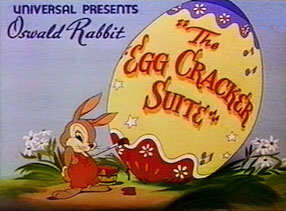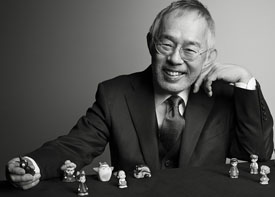 The Foray Voice. I love and respect June Foray dearly but I always bristle a little when I hear her say that her first animation voice work was for Disney’s animated feature Cinderella (1950). She has told the story so often that I am sure she believes it to be the truth just as other voice-over artists like Mel Blanc told similar inaccuracies about their careers repeatedly over the years. Old issues of Radio Life magazine state that she did voices for cartoons in the 1940s..
The Foray Voice. I love and respect June Foray dearly but I always bristle a little when I hear her say that her first animation voice work was for Disney’s animated feature Cinderella (1950). She has told the story so often that I am sure she believes it to be the truth just as other voice-over artists like Mel Blanc told similar inaccuracies about their careers repeatedly over the years. Old issues of Radio Life magazine state that she did voices for cartoons in the 1940s..
One of the earliest was probably The Unbearable Bear (1942) for Chuck Jones where she did the voice of Mrs. Bear. Her mechanically sped up voice can be heard in Walter Lantz’s final Oswald the Rabbit cartoon, The Egg Cracker Suite (1943). I am sure she did others that are as yet undiscovered but as other researchers well know, finding documentation or any kind of confirmation is quite a challenge.
Animated Hawley Pratt. In the Warner cartoon Ain’t She Tweet (1952), the on-screen mailman was a caricature of Friz Freleng’s layout man, Hawley Pratt. Freleng directed this cartoon and Pratt did layouts for it. Pratt directed Señorella and the Glass Huarache (1964), the last Looney Tunes cartoon released by Warners when it originally shut down the department. Pratt also did the layouts for this Cinderella tale set in Mexico.
Royston Stork. In the Warners’ cartoon Baby Bottleneck (1946) there is a reference to “Royston Stork”. Stork was a real person and was a friend of Bob Clampett who directed the cartoon. They had first met in an acting class being taught by movie character actor J. Farrell MacDonald who had appeared in over three hundred films and passed away in 1952.
If It Was Good The First Time. John McLeish was not only the narrator for Warners’ The Dover Boys at Pimento University (1942) but also did some character designs. Then, when he was at Screen Gems, McLeish wrote and voiced a Columbia short cartoon entitled The Rocky Road to Ruin (1943) with a similar storyline of a stalwart hero battling a melodramatic villain for the pure heroine in an angular artistic design. The working title for the cartoon was From Rags to Rags. By the way, in the 2015 ABC television series Agent Carter, a brief segment of the public domain The Dover Boys cartoon is used as part of a subliminal messaging tool to train young girls in the Soviet Black Widow secret agent program.
(Embed Thanks to Thad K.)
Toshio Suzuki on Miyazaki. Studio Ghibli’s president and animation producer Toshio Suzuki has always likened his job at the studio to running a small business where animation legend Hayao Miyazaki is a father figure.
Before Ghibli, he was the chief editor of the animation magazine Animage. He got involved with the production of the 1984 film Nausicaa of the Valley of Wind and by 1989 had moved to Studio Ghibli where he became the public spokesman as Miyazaki withdrew from the spotlight to concentrate on his work.

Toshio Suzuki
“One time, Miya-san summoned a couple who he’d heard were living together. He told them that they should get married and to do so at the studio. But the young woman said, ‘I respect you, Mr. Miyazaki, and I know you’re in charge here but please don’t interfere with our private lives’. Upon hearing that, Miya-san looked down, totally crestfallen, as if a daughter had disobeyed her father.
“Miya-san believes you should work at improving your memory. If it’s a text that you find interesting, Miya-san will say, ‘Don’t copy it. Memorize it. If you forget it later, that means the text wasn’t important in the first place.’ He applies the same principle to images. You have to memorize them, down to the smallest detail.
“In contrast, Miya-san has little recollection of the past. He doesn’t remember things that happen in his daily life. What he remembers is always related to his imagery and creations. It’s just amazing.
“We never made and will never make a movie catering to foreign audiences. We operate here in Japan – or in Koganei, to be perfectly precise. It’s nice to see our work recognized outside Japan. But we must not forget that we make movies here in Koganei – a town we know as well as the back of our hand –and for the people living in this area.”
The Real Origin of the Madagascar Penguins. DreamWorks CEO Jeffrey Katzenberg had a high concept of a “Hard Day’s Night” style of movie but starring animated penguins. Producer Mireille Soria and director Eric Darnell began developing this faux ‘”rockumentary” about four penguins that made great music together and the tragic effects of fame on the group. The filmmakers used an early Beatles press conference to create a one minute clip with some endearing penguins.
 Filmmaker Tom McGrath had been working for a year on a half on an animated movie of his own featuring penguins for a small independent production company but it was a more realistic story. The project fell through and McGrath went to DreamWorks where he saw the snippets of various projects including the penguins as the Beatles.
Filmmaker Tom McGrath had been working for a year on a half on an animated movie of his own featuring penguins for a small independent production company but it was a more realistic story. The project fell through and McGrath went to DreamWorks where he saw the snippets of various projects including the penguins as the Beatles.
He hit it off with Eric Darnell but as soon as he signed on, the project was put on hiatus because while DreamWorks got music clearances from three of the Beatles, George Harrison (and later his estate) refused.
A few months later, McGrath became a storyboard artist on “Madagascar” (2005) and added a scene with penguins with a prisoner of war sensibility and it was a hit. McGrath got moved from story artist to co-director.
Katzenberg Celebrates the Differences. At a media conference in New York in March 2005, Jeffrey Katzenberg, then the Chief Executive of DreamWorks Animation SKG Inc., said “The single greatest fiction about animated films is the possible glut of movies that are looming. It’s not as though all of these movies are the same. It’s not like they’re all James Bond movies… they couldn’t be more distinctive.”
Katzenberg was the guy who when he discovered that Finding Nemo was in development wanted his studio to do a fish film, when he heard that both Disney and Warners were developing films about animals escaping from a zoo wanted a similar film and of course produced ANTZ just before the release of A Bug’s Life.


 Jim Korkis is an internationally respected animation historian who in recent years has devoted his attention to the many worlds of Disney. He was a columnist for a variety of animation magazines. With his former writing partner, John Cawley, he authored several animation related books including The Encyclopedia of Cartoon Superstars, How to Create Animation, Cartoon Confidential and Get Animated’s Animation Art Buyer’s Guide. He taught animation classes at the Disney Institute in Florida as well as instructing classes on acting and animation history for Disney Feature Animation: Florida.
Jim Korkis is an internationally respected animation historian who in recent years has devoted his attention to the many worlds of Disney. He was a columnist for a variety of animation magazines. With his former writing partner, John Cawley, he authored several animation related books including The Encyclopedia of Cartoon Superstars, How to Create Animation, Cartoon Confidential and Get Animated’s Animation Art Buyer’s Guide. He taught animation classes at the Disney Institute in Florida as well as instructing classes on acting and animation history for Disney Feature Animation: Florida.




















































June Foray did a lot of un-credited voice work. Her voice pops up in old radio programs, children’s records, cartoons, and live-action movies. Even after her rise to prominence as a top voice artist, second perhaps only to Mel Blanc, she continued to perform occasionally in venues where she received little to no recognition. Her voice is quite distinctive so it’s hard to mistake. She provided puppy barks for “I Love Lucy” and did the voice of baby Tabitha when the child “spoke” under the influence of magic in an early episode of “Bewitched.” On top of those types of cameos, she did so many cartoon voices it would be hard to count them all.
It’s pure speculation on my part, but according to what I have read about Disney, the feature film of Cinderella was in the works for many years. I would guess it is entirely possible that as early as 1941 or 1942 they may have been doing test recordings or auditioning voices for Cinderella, just before the war forced them to put many of their projects on hold. So while it’s entirely possible that June may be mistaken in her recollections, I’m guessing that if she is referring to early voice tests for the film, it’s also possible that she may be accurate.
Another was Saul Bass’s Acemedy-Award winning 1968 ”
Why Man Creates”, that famed mixed=media film. Foray can be heard as her Rocky voice when a copwboy gets shopt defending the poor guy.June:”Well…I’m not an expert, but speaking as..(forgot the rest)”.
I heard June Foray not long ago and didn’t even realize it. It was an episode of an old radio show called “Night Beat,” a ‘hard-boiled’ type series starring Frank Lovejoy as a newspaper reporter rather than the usual cop or private eye. (Good series too.) Lovejoy’s character was looking into a murder case in which a cat figured, yowling around everyone’s windows. When they ran down the cast at the end, it included June Foray. I stopped a minute wondering where she was in the show, as Lurene Tuttle was the only female in the script…then I realized, June was the CAT!!
She also shows up on Capitol’s “stereo demonstration” record as a bowler who rolls a strike from your left speaker to your right.
On June Foray – the Walter Lantz Oswald cartoon The Egg-Cracker Suite was June’s first starting role in animation (she was the voice of the cuckoo screaming at that sleeping rabbit to take out the boiled egg and the little bunny carrying the ginormous egg.)
And on The Dover Boys of Pimento University – take a peek in the original LATAM Spanish version of the Dover Boys. It a hysterical laugh fest filled with crazy ad lib gags in LATAM Spanish including the scenes involving that “evil cad” Dan Backslide trying to get this purloined hands on Dora (known as Aurora in the LATAM Spanish version) Standpipe and Dora/Aurora giving Dan a few MMA skills on him while screaming in Spanish “¡¡Afuera!!” (“Get Out!” or “Scram!”) after flinging poor Dan across the parlor room.
On a similiar note, it’s agreed that Janet Waldo started voice wise as Judy Jetson but (info from Keith Scott) Sara Berner’s latterday Warner Bros.voice as Daisy lou Rabbit ion Freleng’s 1948 “Hare Splitter” on “Carrots” SOUNDS like Janet….. (Bea Benaderet was the go-to girrl/lady for voices at WB at this time,though..)
Foray also did the uncredited overdub of the daughter in the final episode of The Twilight Zone, The Bewitchin’ Pool, which was one of the most inept productions Rod Serling ever put his name on. Her interview in the DVD bonus features for the Talky Tina episode is worth watching for more info on her early career.
Wasn’t that Mary Badham (Scout in “To Kill a Mockingbird”) as the daughter?
Other places I’d heard June’s voice: in the Dick Powell movie “Susan Slept Here,” he played a screenwriter, and he’s watching a movie he scripted on TV – we hear Foray and Paul Frees enact the romantic dialogue. In the cheesy mid-60s flick “The Perils of Pauline,” based on the 1914 serial, June is heard as baby Pauline.
I had a tape of old commercials some years ago; there was one for Mattel’s talking Matty, Sisterbelle and Casper dolls (probably taken from “Matty’s Funday Funnies”), and June voiced all three. Oh, yeah, and the Chatty Cathy doll – June did the voice on the commercial. I don’t know if her voice was heard on the actual dolls.
She also voiced the dragon in the Lost in Space episode “The Questing Beast” (with her Dudley DoRight co-star Hans Conried playing the knight chasing the dragon) and the “Mama Bear” in the live-action feature The Two Little Bears (1961). I don’t think she was credited for either one.
June Foray was involved in one of my more embarrassing moments. She was on a panel at the San Diego Comicon one year, and when the floor was opened to questions, I asked about her voice part in the 1989 “Little Nemo” movie. She looked a little blank and said she wasn’t in that movie, and wasn’t “Little Nemo” something from the Thirties? I knew I had seen her name in the credits, but since she obviously didn’t remember doing the part (or even the movie itself), it seemed futile to push it, so I let it slide while everybody in the audience probably wondered if I was disconnected in the head or something. I just checked the IMDB for that movie, and she’s listed in the Cast and Crew for doing the voice of a character referred to as “The Librarian.” I don’t remember the character (though it has been a while since I’ve seen the movie), and I wonder if it Foray’s scene was cut in the final edit (probably what I wanted to ask her about). But Foray has done so much work over the years that it’s understandable if she doesn’t remember everything…
June Foray was involved in one of my more embarrassing moments. She was on a panel at the San Diego Comicon one year, and when the floor was opened to questions, I asked about her voice part in the 1989 “Little Nemo” movie. She looked a little blank and said she wasn’t in that movie, and wasn’t “Little Nemo” something from the Thirties? I knew I had seen her name in the credits, but since she obviously didn’t remember doing the part (or even the movie itself), it seemed futile to push it, so I let it slide while everybody in the audience probably wondered if I was disconnected in the head or something. I just checked the IMDB for that movie, and she’s listed in the Cast and Crew for doing the voice of a character referred to as “The Librarian.” I don’t remember the character (though it has been a while since I’ve seen the movie), and I wonder if it Foray’s scene was cut in the final edit (probably what I wanted to ask her about). But Foray has done so much work over the years that it’s understandable if she doesn’t remember everything…
I did sorta wonder if her part came in during this song sequence, there’s even a librarian showing up but it doesn’t sound like her voice. Maybe they changed their minds but credited her anyway.
https://www.youtube.com/watch?v=-GFq_ZFBHq8
For reference, here’s the opening title of the film that lists Foray’s credit.
http://i.imgur.com/QrqtcdD.png
The basic premise startup behind the Columbia cartoon and the Warner one is indeed the same, but the plots diverge quite a bit. Chuck Jones went for an unexpected twist ending, and the girl was the one who had the money. In The Rocky Road to Ruin the slicker already had robbed a lot of money, so the girl picked him, only to return to the modest guy in the end – it’s a lot more straightforward. Besides, the Columbia short has some scenes that in a way remind me of Fresh Airedale (it really took a long time for him to be sorry).